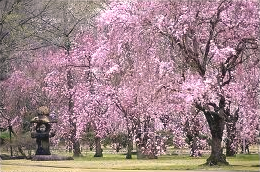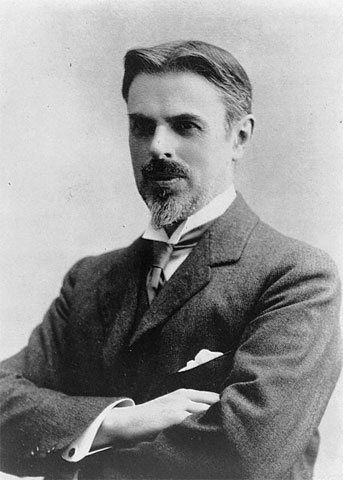

|
| ||||||||||||||||||||||||||||||||||||||||||||||||||||||||||
|
| |||||||||||||||||||||||||||||||||||||||||||||||||||||||||

| ||||||||||||||||||||||||||||||||||||||||||||||||||||||||||
| Listen to the poem Loveliest of Trees by A. E. Housman read by Alexander Scourby. |
Loveliest of trees, the cherry now Now, of my threescore years and ten, And since to look at things in bloom |

FormThis poem is in the form of rhymed couplets. MeterThe meter of the poem is basically iambic tetrameter; that is it has four major stresses in each line with a pattern of unstressed/stressed syllables. For example, the second line fits the metric pattern.
Other lines do not exactly fit the stresses of the meter to offer variety and different emphases. The first line gives emphasis to the word loveliest with the stress on the first syllable followed by three unstressed syllables. The fourth line (as well as lines 6 and 10 leaves off the first unstressed syllable to provide some variety in the rhythm of the piece. Note however that the pattern of four stressed syllables per line is strictly adhered to. The result of the meter is a pleasant pattern that adds a smooth flow and cohesion to the poem and words. TypeThis is a lyric poem expressing an emotion or idea produced through an observation of nature.Rhyme
ImageryThe strongest image in the first stanza is that of early spring. Without using many figures of speech, Housman draws a picture of a countryside path lined with blossoming cherry trees. This image is a reference to youth and beginnings. The reference to white and Easter suggest naiveté and purity. The cherry tree represents the beauty of nature and spring. The second stanza uses a riddle-like method to tell us the speaker’s age. The first figure of speech here is a reference or allusion to the age allotted to man in the Bible – threescore years and ten- or seventy years. The reference to spring in line 7 is a synecdoche; spring here stands for a full year. In the third stanza, Housman uses the synecdoche things in bloom to represent all of life and woodlands to represent the world, just as hung with bloom in the first stanza represents spring and the beginning of life. Cherry trees come in white, pink, dark pink, yellow, and green varieties. Some blossoms change from white to pink over a few days. See pictures of cherry trees white with blossoms in spring and white with white snow in winter, below. The last stanza refers to these color differences. In the last line, cherry blossom hung with snow is a double metaphor, a reference to both real snow in winter and to white cherry blossoms that look like snow in spring. It's another reference to the bloom of spring, like the one in the first stanza, and it reminds us that the end of life is with us at its start. Woodlands represent inner life, not just the outer world. I will go to see the cherry hung with snow encourages us to search for beauty everywhere and in every moment of life, not only in nature, and not only when we're young. The cherry tree is the loveliest of trees because it symbolizes all this beauty. PeriodThis poem was written in 1896 as part of Housman’s book The Shropshire Lad at the end of the Victorian period and the beginning of the Modern. However, the poem is strongly reminiscent of the Romantic period in its natural imagery and optimism. This is often the case in works of later poets who draw on earlier periods for inspiration. ParaphraseThe beautiful cherry tree stands out along the woodland path when it is blooming white in springtime. I’m twenty years old and can expect to live to be seventy. Since I only have about fifty years left in my life, I will look at nature’s beauty in all seasons. theme and MeaningUsing the theme of the beauty of the natural world, the poet is expressing the view that we should seize every opportunity to experience life in all its beauty. Because of its lighthearted tone (especially notable because of the riddle-like second stanza), this is an optimistic poem despite a reference to the shortness of man’s tenure in the world. The poem's briefness, short lines, and simplicity remind us that life is short; they urge us to speed. |

 This example is a practical demonstration of the principle that you get
the most from a poem when you analyze it.
This example is a practical demonstration of the principle that you get
the most from a poem when you analyze it.
As you explore this example, keep in mind that there is no one right way to analyze the technical aspects of a poem. Many viable and effective methods for analyzing the technical aspects of a poem have been devised and can be applied with approximately equal success; The Muse's Approach is only one of them. The most important thing is not to find the "best" method; the most important thing is to do the analysis.
The test for whether a method is viable? Any sound analytical methodology for approaching a poem will lead to the same result as any other; that is, it will elucidate the technical design and implementation that the poet has conceived and implemented—it will lead to a better understanding of the language of the poem itself, of what it says and how it says it.
This fact does not imply that there is only one way to understand a poem. Poetry, as with any art, is a subjective experience. There can be a large number of possible interpretations of a poem's meaning that are consistent with its language; the same words may evoke different feelings or thoughts. In principle, all reasonable interpretations of a poem are equally "right" so long as they are not absurd or irrelevant, even if they contradict or conflict with one another.
One example will not make a master analyst of you. To mature as a reader and listener of poetry, you will need to know more and more about poetry's technical elements and to cultivate your analytical skills; you will have to acquire a knack for deftly applying what you know when you approach poems in the future.
As you progress into the realm of poetic analysis, you may encounter poems deliberately intended by the poet to convey multiple meanings. Other poems may be designed to encourage you to perceive more than one valid interpretation or have more than one relevant emotional reaction. Some may be ambiguous; they may even leave you wondering what they mean or how they make you feel. For a number of reasons, including your unique point of view and the personal life experiences you bring to bear, your interpretations and reactions may differ from those of other readers; you may even disagree with yourself from one reading to the next or at different times in your life.
Meaning and emotion are fundamental human capacities. The best approach you can take to develop your faculty for poetic interpretation is to deliberately exercise your natural powers of imagination and insight whenever you approach a poem. Read all sorts of poems and keep an open mind to all their possibilities; let yourself go.
Almost everyone has an innate ability to understand and love poetry; it just has to be developed. No doubt, you have one too. After a while you will develop your own inborn ability to make up your own mind about what a poem means, to experience and react to it, and to know with certainty in your heart of hearts what you genuinely feel about it.

Search this web site with Electricka's Search Tool:
tap or click here
Electricka's Theme Products
Shop At Cafe Press
This web site and
its contents are copyrighted by
Decision Consulting Incorporated (DCI).
All rights reserved.
Contact Us
Print This Page
Add
This Page To Your Favorites (type <Ctrl> D)


You may reproduce this page for your personal
use or for non-commercial distribution. All copies must include this
copyright statement.
—Additional
copyright and trademark notices—
| Exploring the Arts Foundation |
 |
| Today's Special Feature |
| Search Now |
| To Do | ||
|
| Related Pages |
| See Also |
| Our Blogs |
| Our Forums | ||
|
|
Resource Shelf |
|
|